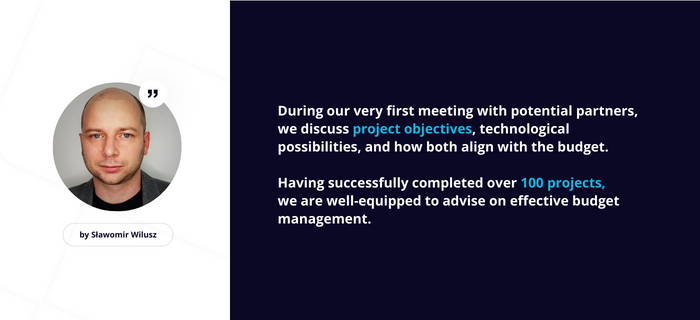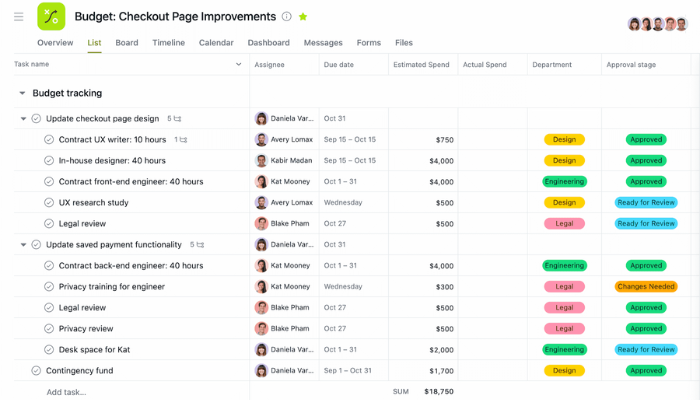Begin with your objectives and end deliverables. Break the project into phases and milestones. Ensure your budget is detailed, time-bound, and measurable, incorporating additional costs like marketing. And always reserve a portion of your budget for MVP.
In this blog post:
- The biggest threats and challenges in budgeting IT projects.
- A checklist for a sound IT budget.
- Support from specialists.
In research conducted in 2021 by the Project Management Institute, it was found that only 62% of projects were completed within their planned budget.
IT projects, due to their complexity, often suffer from underestimation or are planned without enough time and funding reserves. The result can be budget overruns, the inability to implement specific functionalities, missed deadlines (critical when working on projects funded by EU funds), or even the risk of complete failure in delivering the product.
The biggest issue lies in consuming a significant portion of the budget on the first version of the product. We suggest to our partners that the first version should not cost more than 50%-60% of the total budget, with the remaining amount allocated for its refinement and expansion during the development of version 2.0.
Planning the budget for an IT project can be likened to budgeting for a home renovation – typically, people undertaking their first renovation tend to underestimate and struggle to stick to the schedule. When building digital products, it’s valuable to seek the expertise of experienced partners, including a software house if you decide to outsource.

Budgeting an IT project – the most significant threats
Defining the vision of the final product that the project aims to deliver is usually not the problem. The bigger challenges lie in determining the technological requirements and implementation possibilities, the timeframe for execution, and potential risks. At this stage, external support is crucial, especially for organizations embarking on a larger project for the first time.
Be sure to pay attention to:
- Selecting the appropriate model for implementing the IT project.
- Allocating a specific portion of the budget for the first version.
- Choosing the right subcontractor if you option for outsourcing.
- Including costs for marketing or contingency budgeting.
Checklist for a great project budget
The first piece of advice we’d gladly share: everything must be documented! Even the most trivial and obvious elements of the project should be recorded in one place and under appropriate categories.
The best solution would be to utilize a project management tool that most organizations have already implemented. Most modern PM tools allow the addition of extra columns/fields related to costs, or come with dedicated templates for budgeting.
#1 Define your need precisely
We mentioned this above. First, define in great detail what the project aims to achieve. End products must be precise and well-documented.
- Specify project objectives and deliverables.
- Based on the above, assess the requirements that must be met to consider the project a success.
#2 Choose the project implementation model
This point is related to the first one. Knowing what you want to achieve and what requirements need to be fulfilled, choose the project implementation model. We write more about this in the guide on collaborating with programmers. In summary, you have the following options:
- In-house execution within your organization, utilizing your current team or building a new one.
- Support or supplementation of the existing team (Body Leasing).
- Building an external team for the project duration (dedicated programming teams).
- Comprehensive project execution by an external company (outsourcing).
Each model has its pros and cons. In the case of outsourcing to a software house, they will help in preparing the appropriate budget.

#3 Determine necessary recources
By resources, we mean the human resources needed for project implementation, time, and additional elements, for example, server infrastructure maintenance expenses after deployment. Even when using a software house, someone within your organization will need to communicate with the partner.
There are always additional costs after deployment:
- Marketing budget.
- Solution maintenance (infrastructure).
- Support. Is it part of the agreement with the software house, or is maintenance the responsibility of the owner after product delivery?
The more precise the budget, the better. Working with a software house makes things easier because, during the first meeting, you can align project goals with their feasibility.
#4 Remember about Iterations
When it comes to the methods of delivering digital products, it's worth asking the software house you plan to collaborate with. The conservative waterfall model is not popular in IT project implementations, but it does have a significant advantage: it's easy to plan and budget.
In the case of agile models, you have the option of choosing an iterative or incremental approach. Although the underlying principle is the same, the iterative model involves releasing subsequent functionalities and product development in iterations (e.g., 1.01, 1.02, 1.03, etc.).
With the incremental model, functionality is added to the product after completing a specific stage. You can see the process visualized by Agile247:


The biggest advantages of the iterative model will be:
- Rapid information gathering.
- Early risk identification.
- Flexibility.
To have the ability to change direction, you must have a budget reserve. Spending all or the majority of funds on the initial versions of the product limits your options.
According to Agile.com, 29% of startups fail due to burning through available funds.
#5 Allocate Time and Cost to Tasks
Now, you need to transform your objectives, requirements, and resources into specific tasks. Think of these tasks as all the activities that must happen to achieve the end product. A basic task list lacking stages or iterations and costs might look like this:

To create a budget from the above tasks, you must add time and cost to each task and group them into stages or iterations. Think of stages as measurable points on the schedule that provide information about the project's effectiveness. For example:

The above description is, of course, simplified to illustrate the process. The budget and product development schedule will be much more detailed.

This is a good moment to take a note and ask the software house what model they work in and why!
#6 Remember: Plan B and Additional Costs
Having defined stages in the project has another significant advantage: you can assess in advance whether the project is on track or not.
- Before starting the project, allocate additional funds in the budget for unforeseen expenses that will surely arise.
- Add a Plan B. For example: if we exceed the budget by 20% at Stage X, we need to do Y.
To respond appropriately to the need for changes arising from budget overruns, monitor expenses continuously.
Support from Specialists
Budgeting for an IT project is a comprehensive process that can be overwhelming, especially for the first time. For this reason, support from specialists will save time, nerves, and reduce the risk of budget overruns.








